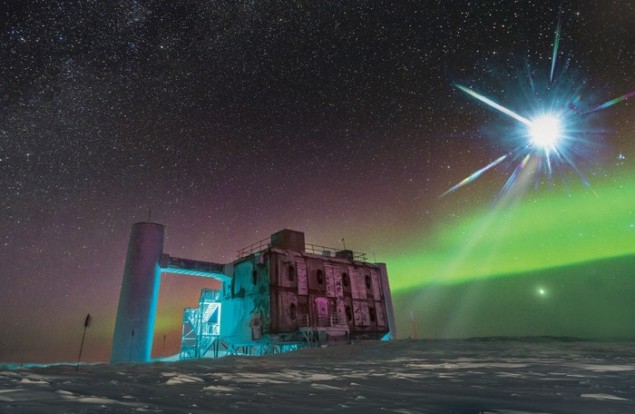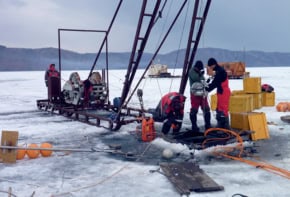
Some high-energy neutrinos detected in the Antarctic ice and thought to have come from outside the solar system may have been produced in Earth’s atmosphere. That is the conclusion of physicists in Poland and Brazil, who have analysed how neutrino detections made by the IceCube Neutrino Observatory may have been shaped by the presence of heavy charm quarks within protons and neutrons. Their result implies that this “intrinsic charm” plays a key role in the generation of high-energy neutrinos when high energy cosmic rays interact with nuclei in the atmosphere.
The IceCube Neutrino Observatory uses one cubic kilometre of the Antarctic ice sheet to detect cosmic neutrinos from outside the solar system. The process involves a neutrino interacting with the ice to create secondary charged particles. These particles are moving faster than the speed of light in ice and therefore produce Cherenkov light, which is detected by some of the hundreds of photomultiplier tubes positioned at regular intervals along a grid of cables suspended within kilometre-deep holes in the ice.
Since 2013 the facility has reported evidence for dozens if not hundreds of cosmic neutrinos. Such particles have energies of at least 100 TeV and are potentially bearers of information about otherwise obscure and distant astrophysical processes. They are distinct from the generally lower-energy neutrinos produced when cosmic rays interact with nuclei in the atmosphere to generate particle showers.
Prompt neutrino flux
In the latest work, Rafał Maciuła and Antoni Szczurek at the Polish Academy of Sciences in Kraków, along with Victor Goncalves at the Federal University of Pelotas in Brazil, argue that some of the supposedly cosmic neutrinos may in fact be of the more humdrum atmospheric variety. These neutrinos would form what is known as the prompt neutrino flux, generated along cosmic rays’ forward trajectory via the production and decay of charmed mesons – particles containing a charm quark or charm antiquark bound to another quark of a different flavour.
The researchers come to this conclusion after using both the IceCube data and results from the Large Hadron Collider (LHC) at the CERN laboratory in Geneva to try and pin down the extent of any intrinsic charm within protons. In contrast to the simple picture of protons being made up of two up quarks and a down quark bound together by gluons, physicists now know that they also contain a sea of quark-antiquark pairs flitting into and out of existence. However, exactly what fraction of those quarks are charm quarks has remained the subject of debate.
The LHC results used by the trio were reported in 2019 and came from experiments that collided protons with a stationary target of helium or argon gas inside the LHCb detector. These collisions would have had enough energy to break free any charm quarks or antiquarks existing within the protons but not so much energy that the collision products would have travelled in a forward direction – where they would have been impossible to measure (as is the case with proton-proton collisions.)
New model
In earlier work, Maciuła and Szczurek compared those results with a new model they developed describing how proton collisions yield pairs of charmed mesons. Although their model could not be used to calculate from first principles the likelihood of a charm quark or antiquark escaping a proton during such collisions, they were able to plug in a variety of different probabilities and then compare the model results with those from LHCb to settle on a best-fit number. Their result was 1.65%, which is the probability of finding intrinsic charm quarks inside a proton (as distinct from charm quarks that are produced by gluons during proton-proton collisions).
What they and Goncalves have now found is that a similar percentage can be obtained by modelling the production and decay of charmed mesons within the Earth’s atmosphere. By again varying the intrinsic charm probability within their model, they closely matched IceCube’s observations when that probability is around 1.5%.

Cosmic neutrino points back to blazar driven by supermassive black hole
They argue that should that figure turn out to be correct, scientists would be forced to reinterpret some of IceCube’s highest energy neutrinos as being of atmospheric rather than cosmic origin. But they stress that there is still considerable uncertainty in their result. This is because of the different values that can be obtained depending on the exact workings of the strong force – which describes interactions within and between protons and neutrons. One thing that is not clear is whether or not the proliferation of gluons inside protons at high energies tends to self-regulate or “saturate” above a certain energy.
Reducing that uncertainty, they explain, can be achieved by better understanding and measuring both the prompt neutrino flux at IceCube and the production of charm mesons at the LHC. New experiments involving high-energy neutrinos at CERN could also help, they add – namely FASERν and SND@LHC.
Despite the new findings, IceCube principal investigator Francis Halzen of the University of Wisconsin-Madison in the US is confident that intrinsic charm has only a small effect on his collaboration’s astrophysical results. He acknowledges that he and his colleagues have so far been unable to pinpoint the exact contribution of charm-generated neutrinos to their high-energy signals. However, he says that their failure to do so is precisely because the cosmic flux at those energies is so large. “It may be beyond the sensitivity of our measurements, especially because those have been designed to reject atmospheric neutrinos,” he adds.
The research is described in European Physical Journal C and Physical Review D.



